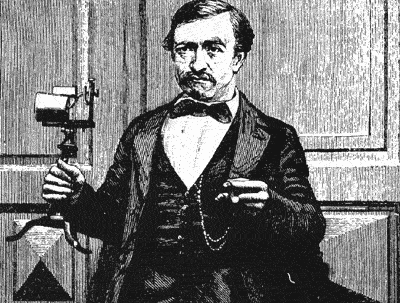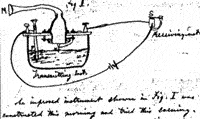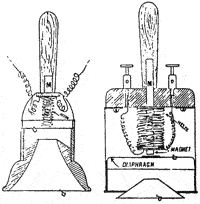The Telephone
Fact Paper 2
© Samuel Kurinsky, all rights reserved

For further details on Emile Berliner and inventing the telephone, microphone, transformer, gramophone, helicopter, Ercoupe and many other inventions go to FP 27-I and FP 27-II
Many histories credit the invention of the telephone to Alexander Graham Bell. Scarcely a mention of the inventors who preceded Bell are to be found in schoolbooks, and indeed, in encyclopedias. It is no wonder that the myth regarding the invention of the telephone, so authoritatively promulgated, is commonly believed. It is a classic case of "Institutionalized Obfuscation." It is true that Bell was one of those who patented an "improvement" on a device known as the telephone. It is not true that he invented it.
The device that Alexander Bell imitated was the electrical equivalent of a childís toy composed of two cans connected by a taut string. Electrical sound transference was a known novelty of the time. Many persons had been experimenting with similar contrivances long before Bell performed his experiment. Bell contributed nothing to the theories on which electrical voice transmission is based, nor was he the first to apply those theories in physical form.
The theoretical background for electrical wave transmission was established by Heinrich Hertz and Leo Graetz. Hertz was a half Jew who brought optics, acoustics, and electro-dynamics under one doctrinal discipline. A discovery by which Hertz is best known was of "Hertzian waves," the transmission of electro-magnetic waves through space. Hertz was also the discoverer of photo-electricity, the basis for television.
Leo Graetz was the son of the famous Jewish historian, Heinrich Graetz. Leo was the first to investigate the dispersal of electrical waves. Thus the telephone, radio, and television are founded on the discoveries of Hertz and Graetz.
The physics having been established, many scientists began to experiment with various means of converting sound into electrical waves and vice versa. Two persons to whom the invention of the precursor to the telephone can be most importantly attributed are Philip Reis and Antonio Meucci. Only one person, however, made the telephone a viable instrument. His name was Emile Berliner, and he was the inventor of the telephone in its present form.
Philip Reis, a self-educated physicist, was born in 1834 and began experimenting with sound devices in his teens. The first attempt by young Reis to reproduce and electrically transmit sound was to construct a crude assembly designed to imitate human ear functions. A violin case was the resonator, a hollowed-out beer can was the mouthpiece, a sausage casing was stretched across it to serve as a diaphragm!
Reis continued to improve the system. Finally, Reis demonstrated a more professional version of what he termed an "electrical eardrum" before the Physical Society of Frankfort, Germany on October 26, 1861. The verses of a song were transmitted from the room over a three-hundred-foot line to a hospital room. Thereafter, there were many other public demonstrations of improved versions of the telephon, a word Reis coined.
The demonstrations started 15 years before Bell took out a patent for a similar device. The presentation in 1861 was the first public demonstration of the successful conversion of electrical into auditory waves.
Reis was sickly, and impoverished, with neither the means nor the stamina to capitalize on the device. He died at forty years of age, two years before Bell is reputed to have summoned his assistant with the words," Mr. Watson, come here, I want you."
On March 22, 1876, a New York Times editorial entitled "The Telephone," lauded Philip Reis as its inventor. Bell was not mentioned in the editorial; evidently the writer had never heard of him. Bell later claimed to have transmitted his fabled message to Watson 12 days before that editorial appeared.
In 1878, two years after Bell took out a patent for an "improvement" on the telephone, European physicists erected a monument to Philip Reis as its inventor. German textbooks accredited Reis with the invention until the Nazis expunged Reisís name from German literature. The name has now been only partially reinstated.
Bell admitted he had seen various publications describing Reisí instrument before he applied for a patent. Nor did Bell initially claim to be the inventor of the device, inasmuch as his patent does not state that it is for an original invention but merely for an improvement on existing devices.
Elisha Gray, another American, was among others who "discovered" the Reis instrument. Gray applied for a caveat for a similar "improvement" only a few hours after Bellís application!
Nor was the Reis invention the only one Gray and Bell were familiar with. There was another brilliant inventor who independently had succeeded in electrically producing sound. In 1849, an Italian, Antonio Meucci accomplished that feat. Alexander Graham Bell was then two years old!
Meucci was born in Florence, Italy, emigrated to Cuba and then to Staten Island, New York. He was a politically active supporter of Garibaldi, who was once a guest in his modest Staten Island home. The house is now a museum and is open to the public.
Meucci filed a caveat, a preliminary description of his invention with the U. S. Patent Office, and termed it a teletrofono. The caveat required that he file for converting it into a patent in 1874. Unfortunately, Meucci became a victim of a ferryboat explosion, and was on the death list for a long time. Destitute and ill, Meucci allowed the provisional patent tp lapse.
Two years after the expiration of Meucciís caveat, Bell took out a patent for his "improvement" on the existing instruments. Meucci sued. Bell was wealthy, and dragged the case on to 1887. In spite of the testimony of a parade of witnesses for Meucci, and of the register of Meucciís caveat, Judge William Wallace decide in favor of Bell. The record of the trial leaves no doubt that the Bell Company, grown rich and powerful by that time, exercised pressure on, or bribed, the judge
Just as pre-Hitler Germany attributed the invention of the telephone to Philip Reis, so Italian references attributed it to Antonio Meucci. They were both partially right!
Emile Berliner (1851-1928) a German/Jew who had emigrated to the United States, had much stronger grounds for claiming to be the telephone's inventor for it was he who made the telephone a practical communications instrument. Emile was born in Hanover, Germany. At 14 years of age, Emile worked to help his father support his ten siblings. He apprenticed in a print shop, and then clerked in a dry goods store. His genius quickly came to the fore. After studying the extant methods of producing the textiles he was handling, teen-age Berliner constructed an improved weaving machine.


CENTER LEFT: 1857: Meucciís teletrofono
CENTER RIGHT: 1867, Meucciís improved telephone as registered in his caveat.
BOTTOM: 1862: The tenth, sophisticated version of the Reis telephon.
